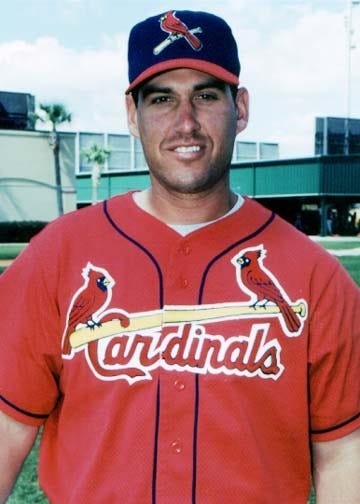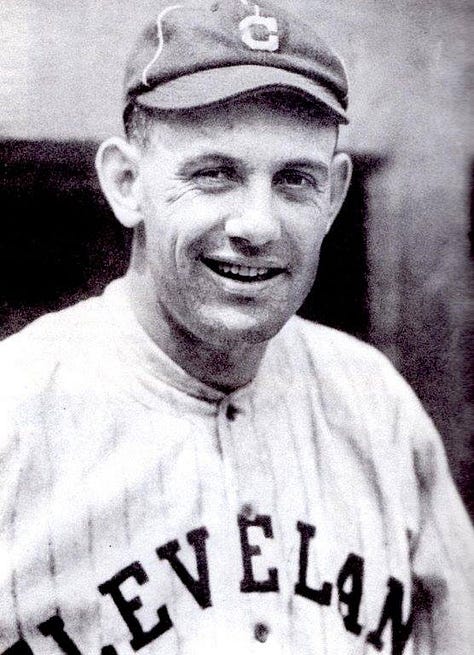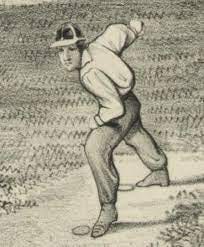James Creighton: Death by Pitch Style
The pitcher who revolutionized the position also died from it
In baseball, many contributions have shaped the game we know and love today. However, there are also players whose legacies have been overshadowed by tragedy. Today, we're going to talk about one such player: Jim Creighton.
James (or Jim) Creighton was a star pitcher in the mid-1800s, known for his unique and unconventional pitching style. He was one of the most talented players of his time and had a bright future ahead of him.
Unfortunately, Creighton's life was cut short due to a tragic accident that occurred during a baseball game. Despite his untimely death, Creighton's legacy has lived on and his story continues to fascinate baseball enthusiasts and historians alike.
In this episode, we'll explore the life of this game-changing pitcher, his contributions to baseball, and the events that led to his untimely death. So please sit back, relax, and join us as we dive into the tragic story of James Creighton.
Early Life

Jim Creighton was born in Manhattan, New York on April 15, 1841. He was the second of six children, and his father was a successful businessman. The Creighton family was well-off and had a comfortable lifestyle.
From a young age, Creighton showed an interest in sports, particularly baseball. He played in the streets and vacant lots of New York City with other children, honing his skills as a pitcher. His family supported his passion for baseball, and his father even built a baseball field in their backyard for Jim and his siblings to practice on.
Creighton attended the Brooklyn Collegiate and Polytechnic Institute, where he continued to play baseball and other sports. He was known as an excellent student and athlete, and his talents on the baseball field quickly earned him a reputation in the local baseball community.
Overall, Jim Creighton's childhood was marked by a love of sports and a supportive family who encouraged his interests. His early experiences playing baseball laid the foundation for his future success as a player and pitcher.
One of Pro Baseball’s First Celebrities

Creighton rose to fame in 1858 when he joined the Star Club of Brooklyn. He quickly became one of the team's star players, and his reputation as a skilled pitcher spread throughout the baseball community.
In 1859, he helped lead the Stars to an undefeated season, cementing his status as one of the best players in the game. He then went on to play for the rival Brooklyn Excelsiors (or the Excelsior of Brooklyn) club. They we one of the highest-profile clubs of the time, and his pitching style immediately made him a national sensation.
Creighton's success on the baseball field brought him a level of fame that was unusual for athletes of his time.
He was a regular in newspapers and magazines, and his image was even used to sell products such as cigars and tobacco.
Fans would often follow him around on the streets of New York City, asking for autographs and congratulating him on his latest victories.
Unfortunately, statistics for baseball in the mid-1800s were not reliably recorded in the same way they are today, so we don't have detailed information about Jim Creighton's pitching statistics However, we can take quotes from the time period’s publications about Creighton’s popularity and importance to the game.
"Creighton, the famous pitcher of the Excelsiors, is the lion of the day, and receives the homage of the multitude as he passes along the streets." - New York Daily Tribune, August 29, 1859
"The famous pitcher, Jim Creighton, of the Excelsiors, has made a great many friends by his uniform kindness and politeness to all." - New York Clipper, July 10, 1858
"The wonderful pitching of Creighton, who throws the ball with great speed and accuracy, is the admiration of all." - New York Sunday Mercury, August 14, 1859
Historians who study this period in baseball’s history have plenty to say about Creighton’s impact and legacy on baseball, too.
"Creighton was a player of extraordinary skill and talent, and his contributions to the game of baseball were significant. He was a true pioneer of the sport and will always be remembered as one of the greatest players of his time." - David Fleitz, "Jim Creighton: The Triumph and Tragedy of Baseball's Forgotten Hero"
"No pitcher of his day was more successful or more famous than Jim Creighton. He was a true innovator and a master of his craft." - George Vecsey, "Baseball: A History of America's Favorite Game"
"Jim Creighton was a genius on the baseball diamond, a player with an innate understanding of the game and a rare ability to execute his vision on the field." - John Thorn, "Baseball in the Garden of Eden: The Secret History of the Early Game"
These quotes, along with others, demonstrate the high regard Jim Creighton held by his contemporaries and historians who studied his life and career.
Creighton’s most important mark left on the game was his innovative pitching style and his success on the field made him a favorite among fans and players alike. He was often compared to the greatest pitchers of his era, such as Jim Devlin, Bobby Matthews, and Al Spalding.
Baseball in the Mid 1800’s: A Quick Overview

One of the things that set Creighton apart from other pitchers of his time was his unique pitching style. The rules for pitching the ball during Jim Creighton's era were quite different from the modern game. Here are a few key differences:
Underhand pitching: Instead of throwing overhand as modern pitchers do, pitchers in Creighton's time threw the ball underhand. The pitcher would stand with one foot on the pitcher's plate and the other foot in front of it and would release the ball with an underhand motion. Under the rules of baseball at the time, a pitcher was required to deliver the ball underhanded with the arm locked straight at the elbow and at the wrist
Shorter pitching distance: The pitching distance was shorter than in modern baseball. During Creighton's era, the pitcher's plate was only 45 feet from home plate. The length was later increased to 50 feet in 1867 and then to the modern distance of 60 feet, 6 inches in 1893.
No balls or strikes: Creighton's era had no balls or strikes. The pitcher would deliver the ball to the batter, and the batter could choose to swing or let it pass. Foul balls did not count as strikes, and walks did not exist as a way to advance to first base.
Heavy ball: The ball used in Creighton's era was heavier and larger than the modern baseball. The ball was made of rubber and weighed around 6 ounces, compared to the 5 ounces used in modern baseball. The larger size and weight of the ball made it more challenging to hit and helped pitchers like Creighton to generate more movement on their pitches.
These rule differences and others contributed to a very different style of play during Creighton's era compared to the modern baseball game.
Jim Creighton’s Unusual Pitching Style
What set Creighton apart from his contemporaries was HOW he threw underhanded. Remember, It was the pitcher's job during this time to make it easy for the batter to hit the ball, as fielding was considered the game's true skill.
Jim changed that by being one of the first to make the goal of pitching more about making the batter’s life difficult and producing outs for their team.
Jim Creighton used what observers described as a "low, swift delivery" to his pitches and achieved an unusually high velocity.
After leaving his hand, the ball would "rise from the ground past the shoulder to the catcher. This delivery made it incredibly difficult for batters to hit the ball effectively.
When observing Creighton pitch a baseball, English cricketer John Lillywhite commented:
"Why, that man is not bowling, he is throwing underhand. It is the best disguised underhand throwing I ever saw, and might readily be taken for a fair delivery."
Another observer said that his pitch was "as swift as [if] it was shot out of [a] cannon." Exclesior teammate John (a.k.a. "Jack") Chapman later in his life wrote that Creighton "...had wonderful speed, and, with it, splendid command. He was fairly unhittable."
Despite his success, Creighton's pitching style was controversial. Some critics argued that it gave him an unfair advantage, while others praised his innovative approach to the game. Regardless of what people thought of his style, there was no denying that Creighton was a talented player with a bright future ahead of him.
After Creighton held the famed rival Brooklyn Atlantics to five runs, a meager total for the era, the Brooklyn Eagle dispatched a reporter to determine whether or not his pitch was legal. The journalistic witness reported that Creighton was throwing a "fair square pitch", rather than a "jerk" or an "underhand throw."
Another technique Creighton pioneered was adding a spinning motion to the ball, making it harder for the batters to hit it squarely. He also had a pitch nicknamed the “dew drop”, a high-arcing, slower pitch that would throw batters off their timing.
Jim Creighton’s Fatal Game

James Creighton's life came to a tragic end during a game on October 14, 1862, when he suffered a fatal injury on the field. The game was played between the Excelsior Club of Brooklyn and the Unions of Morrisania and was held at the Union Grounds in Brooklyn.
During the game, Creighton was pitching for the Excelsiors and had been pitching well, with the game tied 0-0 in the seventh inning. On one particular pitch, he wound up and delivered a fast, powerful throw that sailed toward the batter. However, something went wrong, and he suddenly collapsed on the field. It's unclear exactly what happened, but it's believed that he may have ruptured his bladder or suffered some other internal injury due to the force of the pitch.
His teammates and fans rushed to his aid, but they could do little to save him. He was taken to a nearby home and died a few hours later. The news of his death spread quickly, and baseball fans and players across the country mourned his passing.
The Medical Aspects of Creighton’s Death

The exact cause of James Creighton's fatal injury has long been debated and speculated. In the years since his death, medical experts and baseball historians have proposed various theories about what might have caused him to collapse on the field.
One theory is that Creighton suffered a ruptured bladder due to the strain of throwing the heavy baseball. This theory is supported by the fact that Creighton reportedly had a pre-existing condition that made him more susceptible to bladder injuries. However, there is some disagreement among experts about whether a ruptured bladder could have caused Creighton's sudden collapse and subsequent death.
Another theory is that Creighton suffered a thoracic aortic aneurysm, a condition in which the wall of the aorta weakens and bulges outwards. This could have been caused by the strain of his windup routine, combined with the throwing the heavy baseball, which would have put a significant amount of pressure on Creighton's chest and abdominal area. A thoracic aortic aneurysm can cause sudden collapse and death, which may be what happened to Creighton on the field.
There is also some speculation that Creighton may have suffered a head injury due to being hit by a batted ball earlier in the game. However, this theory is less widely accepted than the others, as there is little concrete evidence to support it.
Other Tragic On-Field Deaths in Baseball



While James Creighton's death on the baseball field was certainly tragic, he is not the only MLB player to have died while playing the game. Over the years, several other notable players have suffered fatal injuries on the field, leaving behind a memorable and tragic legacy.
In 1909, Mike "Doc" Powers, a catcher for the New York Highlanders (later known as the Yankees), suffered a fatal injury when he was struck in the head by a ball that deflected off the bat of an opposing player. Powers collapsed and died shortly after the incident.
One of the most well-known examples is Ray Chapman, a shortstop for the Cleveland Indians who was struck in the head by a pitch during a game in 1920. Chapman was rushed to the hospital, but died the next day from his injuries. His death prompted the introduction of a new rule requiring umpires to replace a ball whenever it became scuffed or discolored, which would make it harder for pitchers to throw a "spitball" or other types of pitches that could be difficult for batters to see.
Another notable player who died on the field was Mike Coolbaugh, a first-base coach for the Tulsa Drillers who was struck in the head by a line drive during a minor-league game in 2007. Coolbaugh was not wearing a helmet at the time of the incident and suffered a fatal injury as a result.
These are just a few examples of the many tragic deaths that have occurred in baseball. While safety measures and rules have been implemented to help prevent such incidents, the risk of injury or even death will always be present in this beloved sport.
James Creighton’s Legacy

James Creighton's legacy has been a subject of interest for baseball historians and fans alike for over a century. His tragic death on the field at a young age ensured he would be remembered as one of the sport's most unique and talented players.
Creighton turned the pitcher into a truly defensive position responsible for outs - not just for delivering a hittable pitch to the batter.
Creighton is often credited with being the first pitcher to use different deliveries, such as the “dew drop” or "curve ball" in a game. Pitching delivery styles are now a staple in today’s game.
Creighton was a dominant pitcher known for his accuracy and control on the mound. He led his team, the Excelsiors, to numerous victories and championships during his career.
His success as a pitcher helped popularize baseball in its early years, as fans flocked to see him play and copied his innovative pitching style. He was truly one of the game’s first celebrities.

In the years since Creighton's death, various tributes have been paid to him as monuments and statues. One of the most notable is the Creighton Memorial in Ellicott City, Maryland, erected in 1932 by the Maryland State Historical Society. The memorial consists of a stone column topped with a bronze baseball, and it is inscribed with Creighton's name and the date of his death.
Creighton's legacy has also been celebrated in news stories and articles. In 1937, for example, the Baltimore Sun published an article about Creighton's pitching style and his impact on baseball. The report noted that Creighton was
"one of the greatest pitchers of his time" and that his unique underhand style had "revolutionized" the sport.
Today, Creighton is remembered as a pioneering figure in the history of baseball, whose unique pitching style and tragic death have ensured that he remains a beloved figure for fans of the sport.
While many details about his life and career remain shrouded in mystery, his impact on baseball is undeniable. His legacy continues to inspire new generations of players and fans alike.
Subscriber's Corner ⚾️ 🙌 (FREE PREVIEW)
Would you like to get a taste of what the premium subs get? Here’s an example of just some of the perks you’ll get by signing up as a paid member of the show. Remember, you can support independent sports media for the cost of just one cup of coffee!
Upcoming Episodes
I’m behind - I know it. I still need to schedule John Vampatella, but I’m keeping the team autopsies episode on the Athletics on the upcoming list. Here’s what you can expect for the next four weeks:
Apr 21: Baseball Team Autopsies: The Philadelphia Athletics
Apr 28: Baseball’s 5 Most Significant Rule Changes
May 5: Bob Slaybaugh: The One-Eyed Pitching Ace
May 12: John Vampatella interview
Feedback Opportunity for Next Week’s Show
For next week, I would LOVE to feature some of your comments in the show. Since we’re talking about the Athletics, let me know your thoughts on the following question:
“Do you think the MLB should relocate the current Oakland A’s club? Where would be the best destination?”
*don’t forget to include your first name so I can quote you properly! Sometimes your email address doesn’t give me that info.
See you next week!






